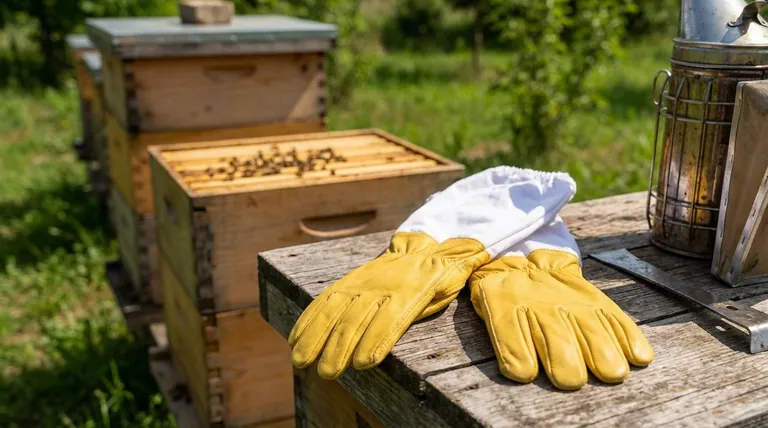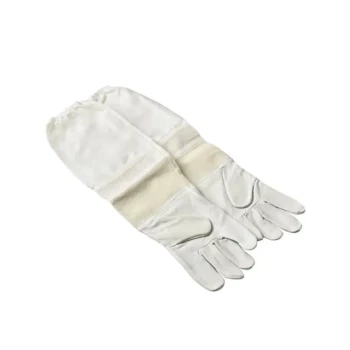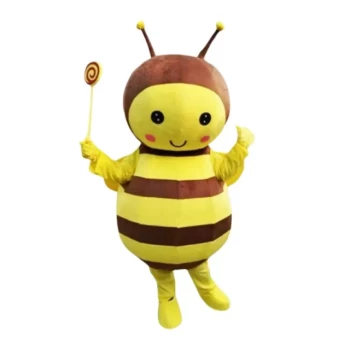At their core, beekeeping gloves are specialized personal protective equipment designed to shield your hands and forearms from stings. They feature long sleeves that extend toward the elbow, an elastic cuff for a secure fit, and are constructed from materials that balance sting resistance with the need to handle tools and hive components.
The most critical decision when choosing beekeeping gloves is navigating the fundamental trade-off between protection and dexterity. The safest glove is not always the most effective, as the ability to work confidently and delicately is just as important as sting prevention.

The Anatomy of a Beekeeping Glove
To choose the right glove, you must first understand its essential components and why they matter. Each feature serves a specific purpose in keeping you safe and effective while working with your bees.
Extended Forearm Protection
Standard beekeeping gloves do not stop at the wrist. They incorporate a long, durable sleeve, often made of thick cotton, that extends up the forearm to the elbow.
This extended coverage ensures there are no gaps between your glove and your bee suit or jacket. An elastic band at the end of the sleeve creates a secure seal, preventing bees from crawling inside.
The Importance of a Snug Fit
A well-fitting glove is a critical safety feature. The glove should be snug enough that it doesn’t slide or feel clumsy, but not so tight that it restricts movement or feels uncomfortable.
Loose, bulky gloves can make you drop frames or crush bees, which agitates the colony and increases the likelihood of stings. A proper fit enhances your dexterity and confidence.
Comparing Glove Materials: Protection vs. Dexterity
The material of your glove is the single most important factor. It directly dictates the balance between feeling safe from stings and being able to perform delicate tasks within the hive.
Cowhide Leather: Maximum Armor
Cowhide leather gloves offer the highest level of sting protection. The thick, durable material is nearly impenetrable to a bee's stinger, providing peace of mind for new or nervous beekeepers.
However, this thickness comes at the cost of dexterity. Cowhide can feel stiff and clumsy, making it difficult to grip small tools or gently manipulate frames.
Goatskin Leather: The Balanced Standard
Goatskin is the most common and widely recommended material for a reason. It is thinner and more supple than cowhide, offering significantly more flexibility and tactile feedback.
While still highly sting-resistant, goatskin provides the dexterity needed to work efficiently and gently. This balance makes it the ideal choice for the vast majority of beekeepers, from beginners to experts.
Nitrile Gloves: For Dexterity and Feel
Some experienced beekeepers opt for thick, disposable nitrile exam gloves. These gloves offer almost no sting protection but provide maximum dexterity, equivalent to working barehanded.
The goal here is not to block stingers but to keep hands clean and potentially reduce a bee's willingness to sting smooth surfaces. They are for confident beekeepers who prioritize feel and are comfortable with the increased risk of stings.
Understanding the Trade-offs
Choosing a glove is not about finding a single "best" option, but about understanding the compromises inherent in each design.
The Cost of Clumsiness
Over-emphasizing protection can be counterproductive. A glove that is too thick and clumsy increases the risk of accidental mishaps like dropping a frame full of bees. This action is far more likely to trigger a defensive response from the hive than a calm, precise movement.
The Risk of Minimal Protection
Conversely, using nitrile gloves before you are comfortable and familiar with bee behavior is unwise. Frequent stings can erode confidence and make hive inspections a stressful experience. These gloves are a tool for experts, not a starting point for beginners.
Why to Avoid Thin Cotton
Thin, cheap cotton gloves should be avoided. They provide a false sense of security and are easily penetrated by stingers, offering little to no real protection. Investing in a quality leather glove is a non-negotiable aspect of beekeeping safety.
Making the Right Choice for Your Hives
Your ideal glove depends on your experience level and primary goal during hive inspections.
- If your primary focus is maximum protection and building confidence as a beginner: Choose a goatskin leather glove for its excellent balance of safety and usability.
- If your primary focus is dexterity for delicate tasks like queen marking: A well-fitted goatskin glove is still the best all-around tool, but you might consider nitrile gloves if you are experienced and accept the risk.
- If your primary focus is reducing bulk and feeling more connected to the hive: Start with goatskin to learn bee behavior, and only transition to nitrile once you can work calmly and predict the colony's mood.
Ultimately, the right glove is the one that allows you to work calmly and effectively, transforming a necessary task into a rewarding craft.
Summary Table:
| Feature | Primary Benefit | Best For |
|---|---|---|
| Extended Forearm Sleeve | Prevents bees from crawling inside; protects up to elbow. | All beekeepers for complete safety. |
| Snug Fit & Elastic Cuff | Enhances dexterity and confidence; prevents clumsy movements. | Preventing dropped frames and agitated bees. |
| Goatskin Leather | Ideal balance of sting resistance and flexibility. | Most beekeepers, from beginners to experts. |
| Cowhide Leather | Maximum sting protection; nearly impenetrable. | New or nervous beekeepers prioritizing safety. |
| Nitrile Gloves | Maximum dexterity and tactile feel. | Experienced beekeepers comfortable with risk. |
Equip your apiary with the right protection. The perfect glove is key to working calmly and effectively. At HONESTBEE, we supply commercial apiaries and distributors with high-quality beekeeping gloves and equipment designed for durability and performance. Let us help you find the ideal gear to protect your investment and enhance your craft.
Contact HONESTBEE today for wholesale pricing on reliable beekeeping supplies.
Visual Guide

Related Products
- Beekeeping Gloves Goatskin Leather with Long Cotton Sleeve for Beekeepers
- Goatskin Leather Beekeeper Gloves with Vent Long Sleeve for Beekeeping Honey Bee Sting Proof Protection
- Mesh Ventilated 3 Layer Goatskin Beekeepers Gloves for Beekeeping
- Goat Skin Leather Bee Sting Proof Beekeeping Gloves with Canvas Sleeve
- Professional Galvanized Hive Strap with Secure Locking Buckle for Beekeeping
People Also Ask
- What is the safest way to handle frames in beekeeping? Master Gentle Handling for a Calm Hive
- Why do some experienced beekeepers choose not to wear gloves? For Superior Dexterity & Hive Welfare
- What is the difference between cleaning cow leather and goat leather beekeeping gloves? Tailor Your Care for Longevity
- What are the advantages of goatskin leather gloves for beekeeping? Superior Sting Protection for Your Apiary
- Should beekeepers wear gloves, and why? Essential Protection for Beekeepers



















